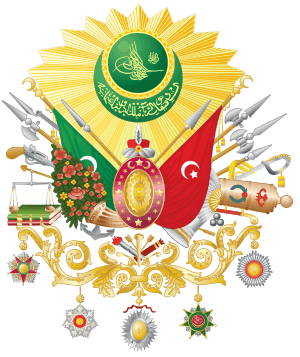Ottoman cuisine
Ottoman cuisine is the cuisine of the Ottoman Empire and its continuation in the cuisines of Turkey, Greece, the Balkans, and parts of the Caucasus and the Middle East.
| Culture of the Ottoman Empire |
|---|
 |
| Visual arts |
|
| Performing arts |
| Languages and literature |
| Sports |
| Other |
Origins
It is clear that Ottoman cuisine was unified and refined in imperial Constantinople (today known as Istanbul), but its origins are unclear:
It is a matter of mere speculation whether the origins of this imperial culinary legacy are to be traced back to Greek antiquity, the Byzantine heritage, or the Turkish and Arab nations, not forgetting Phoenician traditions; nowadays you may find support for any of these claims in various countries in the Balkans and the Near East.[1]
Ottoman cuisine also incorporates many New World foodstuffs, which give it its unique character as compared to its predecessors and its neighbors.
Its culinary terminology includes many Persian loanwords, leading some scholars to conclude that Persian was a major influence.[2] Other experts emphasize the influence of Greco-Roman cuisine:
[D]espite everything, Latin Europe on the one side and Islam and the Byzantine Empire on the other were heirs of the civilizations of antiquity. Muslim culture, after all, developed from a base of eastern Hellenism. Thus, when we see a general similarity between dishes served in both East and West we need to show that they do not have a common, parallel origin in Graeco-Roman cooking before we adduce any oriental influence.[3]
Description
As with the earlier Byzantine cuisine, the center of Ottoman cuisine was in Constantinople, the capital, where the imperial courts and the metropolitan elites had established a refined culinary tradition bringing together elements of regional cuisines from across the empires:
...despite the disintegration of the Ottoman political empire, we can still see the survival of a large region which could be called the Ottoman culinary empire. The Balkans, Greece, Anatolia and the Fertile Crescent... are common heirs to what was once the Ottoman life-style, and their cuisines offer treacherous circumstantial evidence of this fact. Of course, they represent at the same time a good deal of local or regional culinary traditions. Besides, one should not forget that it is typical of any great cuisine in the world to be based on local varieties and on mutual exchange and enrichment among them, but at the same time to be homogenized and harmonized by a metropolitan tradition of refined taste.[4]
Ottoman palace cuisine
This diverse cuisine was amalgamated and honed in the Imperial Palace's kitchens by chefs brought from certain parts of the empire to create and experiment with different ingredients. These chefs were tested and hired by their method of cooking rice, a simple dish. They were brought over from various places for the express purpose of experimenting with exotic textures and ingredients and inventing new dishes.
Each cook specialized in specific tasks. All dishes intended for the sultan were first passed by the palate of the Chesnidjibashi, or imperial food taster, who tested the food for both poison and taste. The creations of the Ottoman palace's kitchens also filtered to the common population, for instance through Ramadan events, and through the cooking at the yalis of the pashas, and from there on to the people at large.
Some of the more extravagant dishes remained as palace specialities and have had only limited diffusion:
Regional culinary influence
The traditions of Ottoman cuisine continue in Albanian cuisine, Middle Eastern cuisine, Algerian cuisine, Bosnian cuisine, Croatian cuisine, Macedonian cuisine, Turkish cuisine, Serbian cuisine, Bulgarian cuisine, Hungarian Cuisine, Greek cuisine, Azerbaijani cuisine, Iranian cuisine, Armenian cuisine, Georgian cuisine, Ukrainian cuisine, Cypriot cuisine, Sephardi cuisine, Syriac-Assyrian cuisine and Romanian cuisine.
Bibliography
- Marianna Yerasimos, 500 Years of Ottoman Cuisine, 2nd English edition, Boyut Publishing, İstanbul, 2007, ISBN 9789752301610
References
- Bert Fragner, p. 53
- Mehrdad Kia, The Ottoman Empire: A Historical Encyclopedia [2 volumes], p. 5.
- Rodinson, Maxime. "Venice and the Spice Trade," in Rodinson, Maxime, and Arthur John Arberry. "Medieval Arab Cookery." (2001). p. 204
- Fragner, p. 52
- Mehrdad Kia (2011). Daily Life in the Ottoman Empire. ABC-CLIO. pp. 230–. ISBN 978-0-313-33692-8.
- Coşkun Yılmaz; Necdet Yılmaz (2006). Health in the Ottomans. Biofarma.
- Jean-Paul Labourdette; Clémence Bonnet (4 February 2009). Petit Futé Istanbul. Petit Futé. pp. 186–. ISBN 2-7469-2337-8.
- Tarım ve köyişleri bakanlığı dergisi. Yayın Dairesi Başkanlığı Matbaası. 1998.
- Sources
- Bert Fragner, "From the Caucasus to the Roof of the World: a culinary adventure", in Sami Zubaida and Richard Tapper, A Taste of Thyme: Culinary Cultures of the Middle East, London and New York, 1994 and 2000, ISBN 1-86064-603-4.
External links

- Culinary cultures of the Ottoman Empire